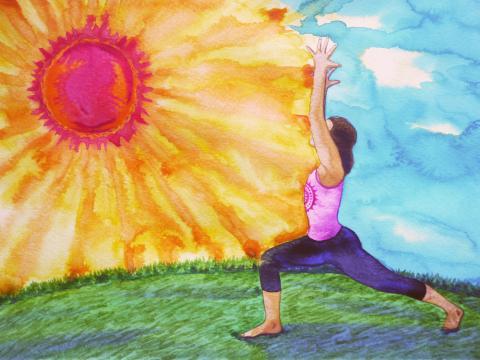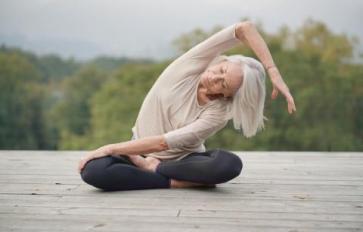
I find that my relationship with myself is greatly affected by my body awareness. Practices like yoga, which require listening to my body and bring me into my body in the moment, help me; these activities are now important paths that I travel repeatedly on the way back to myself. While every yoga session is new, and I am different each day, the mat becomes a place where I develop self-communication and self-trust—important parts of self-love. In an era of media overload, dangerous political movements, and trauma to the natural world, among other difficulties, I find a simple yoga practice very helpful. I’m not a yoga instructor, but a practitioner. Here are some of my favorite poses for self-love.
Forward Folds

Whether standing or seated, forward folds and bends offer a sense of both release and support, of letting go into one’s self and the ground. I prefer to practice forward bends with a relaxed spine, letting my upper torso, arms, neck, and head fall heavy over my lower body. For standing forward bend, or Uttanasana, gently cradling my head or my elbows in my hands feels good.
Putting one’s legs up the wall in Viparita Karani is another nourishing body fold—one that switches up the experience of gravity and the legs’ blood flow. In this pose, the back, neck and head are supported by the floor, which can set one up for a nice restful moment, especially with the hands resting on the lower stomach.
Twists

Twists are so cathartic; stretching and releasing the muscles around the spine that get stiff and tired from sitting and standing for hours on end. Twists are also intended to benefit the digestion and flush the body’s fluids. Because twists require a fair amount of concentration, in that one needs to find that ever-shifting and sensitive place of not-too-far but far enough, and most often bring a variety of sensations flowing through the body, I find them a powerful and simple way to “drop in,” as yoga teacher Adriene Mishler says, to my present-moment experience.
Some of my favorite twists are Jathara Parivartanasana, or revolved belly pose, which is done lying on one’s back, and Bharadvajasana, a gentle seated twist. While I am sitting, I also often like to integrate a neck stretch. Placing one hand over the belly and one over the chest and feeling the energy therein as you breathe is also a wonderful seated activity.
Standing

Gentle warrior, or Shanti Virabhadrasana, which is usually reached through warrior two, or Virabhadrasana II, is, for me, a very comforting pose. It asks us to maintain the lower-body power of the warrior series while allowing the upper body to curve backward in a dancer’s arc, opening and receptive, yet poised. I think the motion matches the name very well; to be in this pose, one must be strong and grounded but also open-hearted and unguarded. Like in much of life, both a rooted presence and a degree of letting go are required.
Tree pose, or Vrikshasana, is also a favorite for me. Because it is a balance-oriented movement, it requires us to be present and to tune-in. Body or kinesthetic balance cannot be forced intellectually or authoritatively, it can only be felt. While this can be maddening at times, it teaches perseverance—it sometimes helps me if I can just laugh when it doesn’t work out and start again. Coming only partially into the pose is a great idea as well, especially when building comfort on one foot. Practicing a similar stretch like standing figure four is another option. Tree pose is also a chest opener, bringing in fresh air to our branching, leaf-like lungs—an added bonus for nature-lovers is that we get to pretend to be trees.
Other Wonderful Poses
Downward facing dog, or Adho Mukha Svanasana, will also always be a beloved stretch that I return to, one that contains the possibility for seemingly infinite interpretations and small variations within the body, consistently awakening and challenging me. During each yoga session, I agree with myself to do my best downward dog for that day; to both stretch myself and be curious about and receptive to where I am in the moment. It’s a pose that encourages me to participate in an ongoing, receptive conversation with my body’s energy, weight and sensations.
And, of course, I couldn’t end a list like this without including child’s pose or Balasana. In one light, it’s another kind of forward fold, but I think it deserves its own mention as a particularly restorative and self-cradling position. There are many variations on this pose, which makes it more accessible to diverse bodies. One way of being in this pose that I am enjoying recently is to let my arms stretch along the floor between my legs (instead of alongside them or out in front) with my hands resting on my feet. The pose of a child can remind us of our innocent, young selves, and invite us to take a break from trying to be better or to be anything in particular. I like to tell myself in this pose that I am enough, and that I always have been.
***
You are enough, too, and you always have been. If you practice yoga, I hope you have your own poses that help you to come home to yourself and cultivate self-love—perhaps we share a few favorites. If you are new to yoga, you may find a gentle exploration of one of the poses above interesting. Regardless, may you be well.








